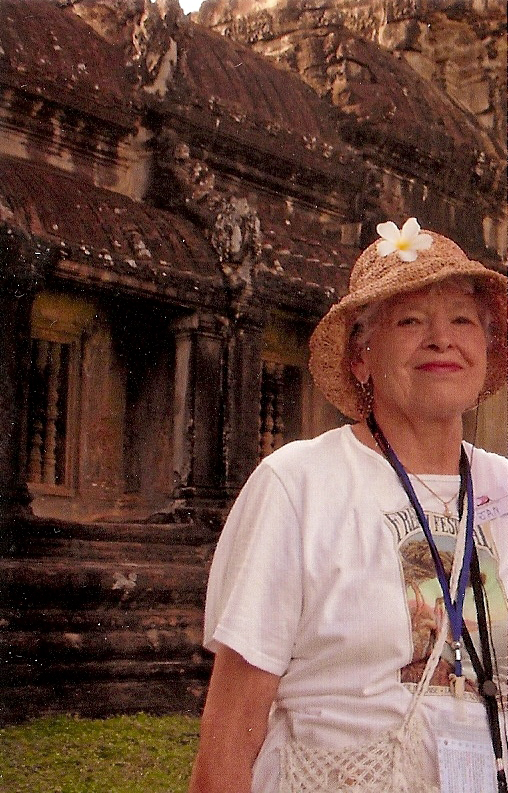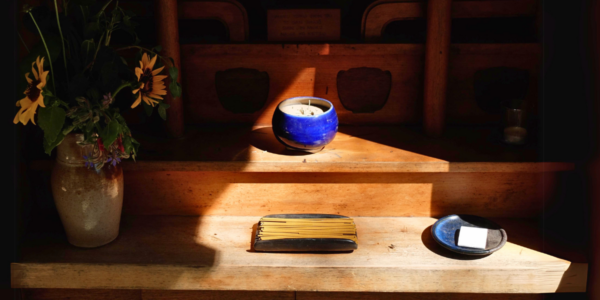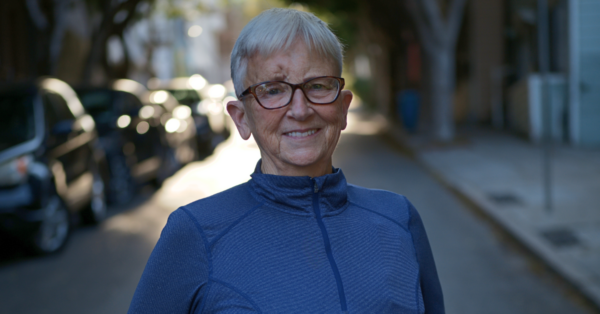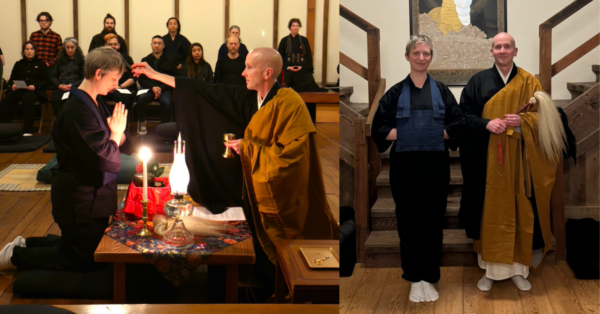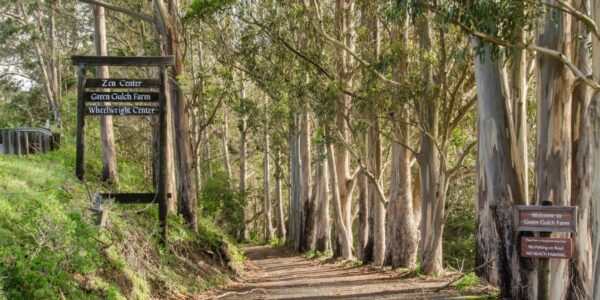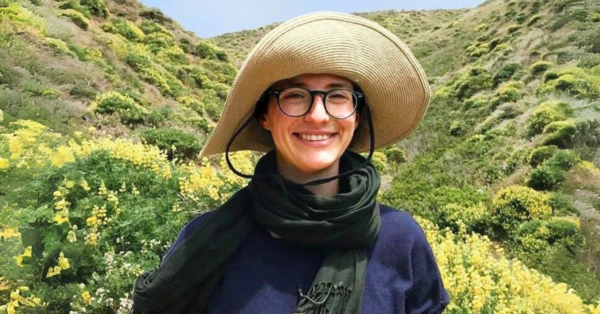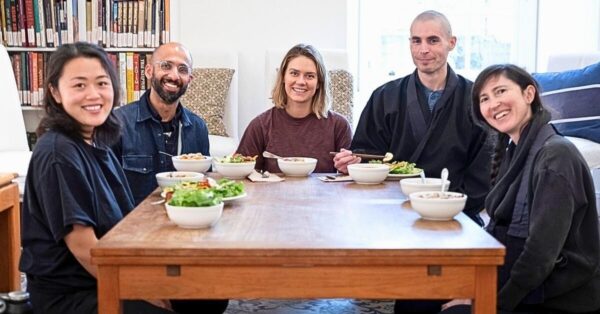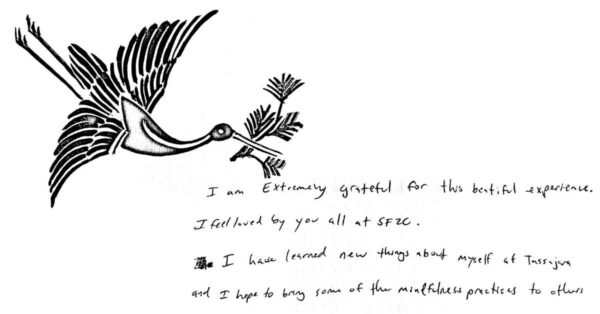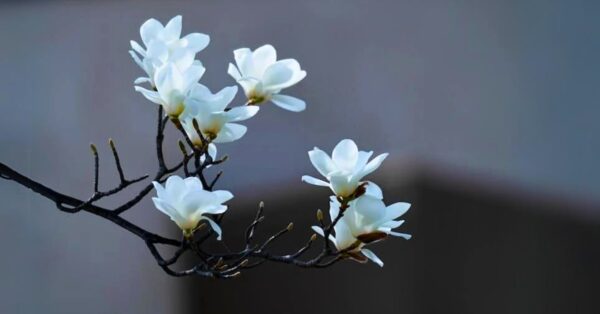So many tempting places I want to stop and explore. Why not turn into the charming small town of Carmel and wander through boutiques, art galleries, ice cream shops, or walk on the beach? Or stop at the Carmel Mission. Or drive along the seventeen mile coast highway, past Pebble Beach Golf Course. Let’s stop at a winery, set among terraced vineyards. There’s so much beauty in the fields, fences and lacy trees. The cows and horses slowly wade through knee deep grass. But we are on a mission.
We turn right off the Carmel Valley Highway onto Tassajara Road. My excitement increases, because this way will take us to the Zen Buddhist Center. The ranch homes and wineries give way to trailers and cabins. We come to a fork in the road with mileage signs but no indication where they lead. We take the left, fourteen mile road. A sign does inform us that the road is impassible in the rainy season.
We pass some fenced pastures and houses but see no cattle or people, which seems spooky The trees on either side of the road are thicker now—small redwoods, pine and the red of the madrona trees when they remove their brown bark coats.
The road is too narrow for my comfort zone and so bumpy that I reach for the handle-grip above my door. Blessing on our four-wheel drive and our fifteen mile per hour speed. The dirt we kick up is a fine light brown and I am forced to keep the window closed, but I still detect the woodsy smell of the trees mixed with the dust of the road.
Now we begin a steep climb, with sharp curves and my prayer that we won’t be facing an oncoming car. There are no shoulders on the road, just a sheer one thousand foot drop to the valley floor on my side of the car. The trees are clinging to the side of the mountain and I cling to the handle- grip.
My bones rattle and I am no longer comforted by the majestic scenery and the mountains I see in the distance when the trees part. All I see is the rocky brown road ahead. The Buddha must reside on the extreme top of the mountain. This must be a test. What if we are on the wrong road? We’ve seen no signs. We meet a huge truck, taking his share of the road and part of ours. I gasp, shake and pray my thankfulness that we did not collide!! Even my expert driver son is breathing heavily. I need a bathroom stop and this takes some time to find a place where I won’t step off the side of the mountain into infinity.
The Buddha does NOT await us when we finally crest the summit and the limit of my endurance. There is no choice but to descend the other side of the mountain and endure more sharp curves and rattling road. I try not to think that in twenty-four hours this will be our return route.
FINALLY the road levels to a parking lot with other cars that have survived. We collect our small packs and walk through a handsome oriental style wooden archway, passing over an arched wooden bridge. There is a small stream on one side of the buildings. The road just traveled ads to the peace and serenity that greet us.
We are assigned to a very small Japanese style cabin. A sign instructs us to remove our shoes, so we sit on the porch chairs to do this, then slide open the rice paper door and step onto a rattan floor covering. There are two four inch futons on the floor with sheets and a quilt, two chairs with no legs (I never do attempt to sit) and a low table. There is a small room with toilet and sink and we need to step on the foot of my futon to negotiate the corner. Our lighting will be furnished by three gas lanterns which we must extinguish by ten p.m. People arise very early here.
After consulting the day’s activity list we go in search of the pools, fed by a natural hot springs, which brought the native Indians to this area long ago. Peter and I separate to the partitioned men and woman’s pools. The choice is suits or birthday suits, inside pools or out. I choose the later. I have the small rock and concrete pool to myself and emerge in the hot water. The water is silk on my bare body and the surrounding trees and the melody of the gurgling creek bring peace to my soul.
Meditation instruction begins at four in the afternoon and we rush to find our way. Shoes are left at the door and we enter the room, facing a shrine to Buddha, with incense sticks ready to be burned. There is a ledge around the room covered in dark green cushions and pillows. A female monk demonstrates the proper way to hold our arms and tented hands, how we incline our heads and which directions to face. A huge vessel is struck several times with a wooden hammer and a lovely mellow tone flows over us. We all face the wall and bow to the cushions in memory of those who have sat there before (a lovely remembrance) and then we face the room’s center and bow again to those assembled and those who will follow. We sit on cushions facing the wall, in the lotus position if it is possible. It is not and I do the best I can. The monk tells us where to place our tongue, to concentrate on our breathing, to relax our every bone. She tells us to keep our eyes half closed for if we fully close them we might fall asleep. Her words glide over us in peace and I relax. When the instruction is finished we again bow, plump up the cushions and exit the room to reclaim our shoes.
Soon the ringing of a metal gong calls us to return and we again remove our shoes, enter the room, this time in the company of the monks. We line up, facing the altar, and the incense sticks are lit and again we hear the lovely sound of the vessel being struck. Stacks of music books are passed from hand to hand, accompanied by bowing and soon the chanting begins. It is in Japanese and too fast for me to join, but it is melodic and soothing and it pleases me. This short service is soon concluded and as we put on our shoes we hear a brass gong calling us to dinner.
We pass along the food table, filling our plates with a vegetarian meal of rice, lentils, a vegetable stew, several condiments I can’t identify and a rice pudding for dessert, all expertly seasoned. Everyone is silent until the first monk walks in and then quiet voices join in conversation. We walk downstairs to scrape our dishes and hand them to the dishwashers. There is tea and coffee in the courtyard and a small bouquet of flowers on the wall with the stream below.
In the evening we are invited to talk to one of the monks and ask questions. We learn that he is married to another monk and they have three children. He tells us that Zen means “meditation” and that this teaches enlightenment, which is the profound realization that one is already an enlightened being.
This awakening is the result of one’s own efforts—meditation. Scripture can offer only limited experience.
Zen Buddhism’s emphasis is on simplicity and the importance of the natural world. In art, a worn peasant’s jar is more beautiful than a perfectly crafted dish. Enlightenment refers to the “full comprehension of a situation”—insight.
I carry a lot to ponder as Peter and I make our way in the dark, back to our little Japanese abode. It may be easier to emphasize simplicity in this quiet environment, away from busy streets, the poverty of inner cities, the shouting of frustrated people, gunshots that ring out all too frequently, hungry people.
After a fairly restful night on the futons we eat breakfast and go for a hike along the river of giant granite salt and pepper boulders. To follow the trail we need to cross the creek four times, stepping on the rocks. I use my walking stick and often the hand of my son. This is rather a foolish attempt for me with a bad knee and a replaced knee and hip. I finally say—enough.
Our next hike is a steep hill climb to a shrine with more flowers and candles. Now we are ready for our final meal, lunch, a scrumptious rice and garbanzo salad, veggies, fruit and a cookie.
As we stow our gear in the car I feel well satisfied with our twenty four hours of retreat from our troubled world. There is so much to talk about on the return trip that it’s magical when we find ourselves back at the fork in the road. The road to Zen was frightening but you can make your own peace. With work, I can keep forever the serenity of Tassajara and return myself there when I choose.
——————————————————————————————————————————
Our writer Janet Maguire lives in Pullman, Washington, a small university town set in the wheatfields. There she and her husband raised four sons who all graduated from the local university, Washington State University (WSU), following in her footsteps. This story is a product of not only her first visit to Tassajara, but also of her five years as a member of a senior creative fiction writing group, led by a WSU professor.
Janet is a family friend of San Francisco Zen Center priest Djinn Gallagher who she has know since Djinn was a little girl; their families have exchanged visits since 1970. It was on one of these visits that Janet came to Tassajara. Since she was in nearby Santa Cruz for her grandson’s college graduation, Janet and her son decided to visit Djinn in Tassajara. Although in the end she did not see her friend Djinn, she wrote, “This was my first visit and it was much too brief.”
With her late husband, Janet also lived in England, Cameroon, Paris and Jordan. Her appreciation for lands far and different from her native wheat fields, led her to travel to Vietnam, Cambodia Angkor Wat, and China. From these travels she got her first exposure to Buddhism. In her picture on the left, she is posed in front of Angkor Wat, the Buddhist temple in Cambodia.
We are very grateful that Janet felt inspired to write about her experience at Tassajara and hope that her story speaks to the experience of many of our summer guests.


